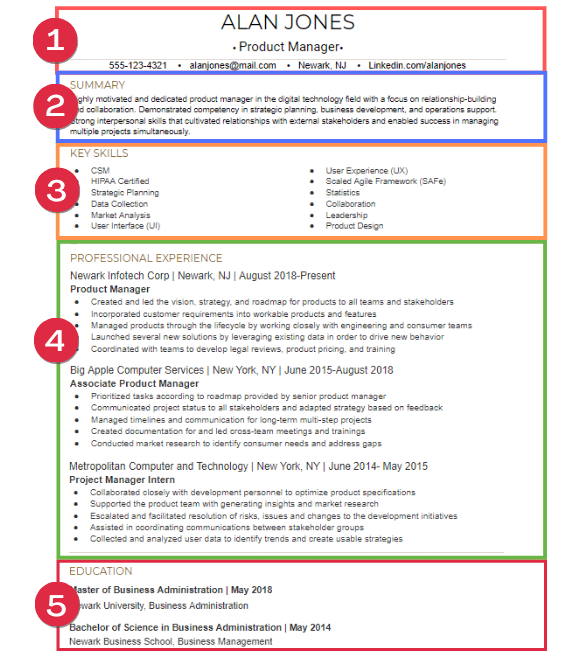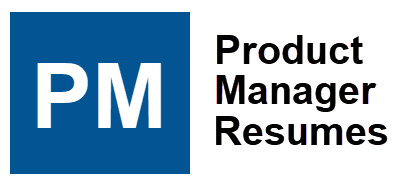Product Management Resume Sample
As you are searching for a new position in the field of product management, you will want to make sure your resume is updated and most reflective of your current skills and experience. Since the employer is likely sorting through piles of resumes, you should make sure that yours paints you as a knowledgeable, skilled, and motivated potential employee. These guidelines will help you to write the most effective resume for landing your dream job in product management.
Things to Keep in Mind When Writing Your Product Management Resume
When you submit a resume to a potential employer, you are creating the first impression of you as a professional. The layout should be organized and the information that you provide within the resume should indicate your most relevant skills, experiences, and knowledge that have prepared you for the desired position. Your resume should be:
Formatted: The employer will expect your resume to be laid out in a specific way. The resume should fill up no more than two pages and should feature section headings and clear evidence of your skills, work experience, and education.
Thorough: While you want to use the space wisely and cannot list everything you've done or experienced, you do want the resume to paint a picture of you as a skilled and competent employee. The employer should walk away with a clear sense of your experiences and achievements and your qualifications for the position at their company.
Enticing: Many of the other applicants will have similar experiences and qualifications, so you want to make your resume stand out. Emphasize the certifications, previous jobs, and achievements that are most notable and likely to get the attention of the employer.
Professional: Employers are not looking for flashy graphics or bright colors on your resume. Stick to traditional fonts and black ink to let your potential employer know that you are serious about the position.
Employers will use your resume to decide if they want to meet you face to face and pull you farther into the hiring process. Follow these tips to help you get the interview and land your dream product management job.

Section 1: Your Contact Information
The very first section of the resume details your name and the primary ways to contact you. You should include your street address, telephone number, and email. If you have a professional social media account, such as LinkedIn, or a website that can offer further insight about your

skills and achievements, you can include this as well. Always make sure that your email address and additional accounts that you share are professional and appropriate.
Section 2: The Summary
The second section is a summary of the rest of your resume. In this part, compose a brief statement of 2-4 sentences that discusses your professional experience and most relevant strengths and skills for your desired position. Incorporating the values or goals of the hiring organization into this section is also helpful to show that you want to work for them and not just anyone.

You want to be careful not to include too much extraneous information in this section. Although you will be tempted to outline all of your accomplishments and goals here, this is just meant to entice the employer to keep reading and find out more.
Section 3: Core Competencies
In the next section, you begin to share your strengths in more detail. The skills section typically features a bulleted list of 12 to 15 competencies relevant to a product management position that you have attained throughout the course of your education and work experiences. For each bullet, use only a few words to share the skill or credential that you have achieved. You want the employer to continue reading through the resume to learn more.

Keep in mind that the qualifications and expectations for product management jobs can vary based on industry and organization. You will want to tailor this section according to the job posting to ensure that you are checking all of the boxes for the employer.
Section 4: Professional Experience
The next and largest portion of your resume is where you will list and provide details about your work experiences. Include your most recent 3-4 positions and outline them using a consistent format to make it easier to read and find information. Begin with the most recent position you have held and list the jobs in reverse chronological order. On the first line for each position, write the name of the company followed by the city and state and finally the month and year of the date you started working there and when you finished.
On the next line, use a few words to describe the job title of your position. Writing "Product Marketing Coordinator" or "Director of Product Management" will cue the employer into the level of responsibility you held and some of the roles that you took on as part of your position.

Finally, underneath this line, include a bulleted list of sentences that describe your accomplishments and responsibilities. Focus on information that is most important and applicable to the job that you are seeking. Try to lead with verbs to show your active role in your work experiences. For example:
Coordinated with the design department to create a user application that improved customer experience
Developed a detailed integration process for new hire onboarding that was adopted company-wide
Collaborated with the design, marketing, and research teams to improve the customer interface experience.
Although it is tempting, be careful not to include every job that you have held and everything you accomplished. You do not want to overwhelm the employer with extraneous information. Focus on the experiences that best prepared you for the job to which you are applying.
Section 5: Education and Licensure
The final section of the resume should list each of your degrees and certifications. Similar to the work experience section, begin with the most recent school you have attended and the degree that you received. Include the name of the school, the type of degree completed, the major studied, and the year in which you graduated. Repeat this process for each of the schools and degrees in descending chronological order.

For most positions in product management, a Bachelor's degree will be expected. In some cases, depending on the industry or specific responsibilities of the job, a Master's degree might be expected. If you have attained a degree that is higher than what is indicated on the job posting, include it in the resume as this could set you apart from the other applicants.
Putting It All Together
Once you have all of these parts written, there is one final step. Always proofread your resume and correct any errors that you notice. Once you have reread and reviewed it a few times, ask a trusted colleague or friend to peruse it as well for tone and ease of reading before you submit it.

To help guide your final review, ask yourself these questions:
- Did you use strong, action-based language throughout?
- Were you consistent with the tense?
- Did you use proper grammar from top to bottom?
- Are there area where you could cut out words to make things simpler and easier to understand?
- What bullet points still include unquantified activity? Can you add some numbers to those?
Finally, the BIG question... does your product manager resume tell your story, clearly and concisely?
If the answer is an unqualified "Yes!" then you should be good to go.
If not, then perhaps now would be a good time to reach out for some professional help.
